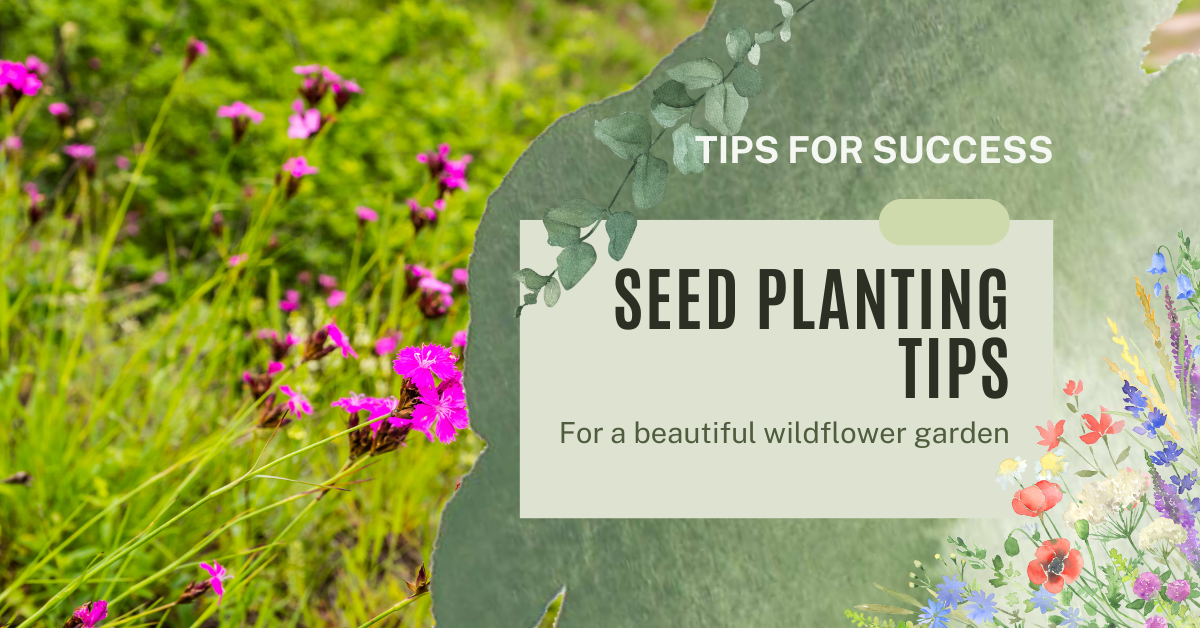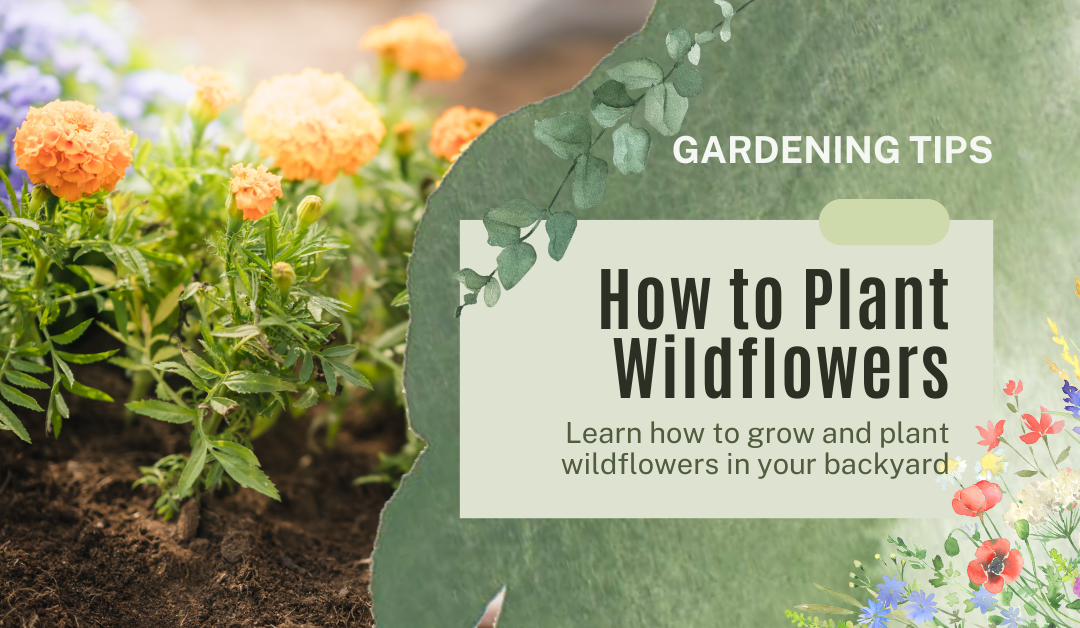Opening a pack of wildflower seeds, scattering them on your ground and hoping for your first blooms in a month or two is a thing of magic. For some, this strategy of planting wildflower seeds works. But for many others, there is quite a bit of work that goes into learning how to plant wildflowers in their:
- Zone
- Soil
In this guide, we’re going to cover the right way to plant wildflower seeds for success in your region and soil.
Planting Wildflower Seeds by Zone
First, you must plant the right seeds for your specific zone. We can go into great detail here, but here’s a quick introduction to planting in your zone:
- USDA Zone 1 – 3: Sow in early spring
- USDA Zone 4 – 6: Sow in fall
- USDA Zone 7 – 11: Sow from September – December
If you’re in zones 7 – 11, you want to be cautious of the cold weather. If you have an unusually warm January, you may be able to sow your seeds even into January.
Note: You can view your planting zone on the USDA’s official website. Just type in your zip code and you’ll see the zones in your state. Multiple zones exist in most states, so you may be able to grow certain plants, while others that are an hour or two may not be able to.
When to Plant Wildflower Seeds?
Notes Annual Wildflower Planting
If you buy annual wildflower seed mixes, you’ll often find that planting in early spring doesn’t work. You didn’t fail or do anything wrong.
Germination will simply occur the following spring.
Often, if the mix of seeds that you purchase has a lot of annuals (many mixes have annuals and perennial seeds mixed together), you’ll have a better chance of germination in the year that you plant them.
The main issue is that you just never know what the season will hold.
If the season has any of the following characteristics, the seeds will need additional watering to grow properly:
- Dry
- Hot
- Little rainfall
Notes Perennial Wildflower Planting
Perennial wildflowers are a lot of people’s go-to option for planting because they come back every year. After all, who doesn’t want their lawn or garden to be filled with beautiful colors every year?
There is good and bad news:
- Perennials are usually more drought-tolerant, but
- Drought protection requires the flower to be well-established
Establishment often occurs in the second and subsequent seasons.
However, you do need to care for these perennials a little more than other types of wildflowers. If your perennials are not thriving, the most common culprit is a lack of rain. Supplemental irrigation will be necessary to keep your plants looking their best, especially if you have an unusually dry spring and summer.
Planting your seeds at the right time and in the right conditions will improve your chances of having your flowers bloom.
How to Plant Wildflowers Based on Site
Once you have a firm understanding of the zone requirements that you have and what it takes to grow certain seeds that you buy, it’s time to look at your land/lawn/garden – wherever you’re planting the seeds.
Sun or Shade
Full sun locations, which are defined as having sun for six or more hours of direct sunlight per day, work best. You may find rare wildflowers that can thrive in the shade, but for the most part, the seeds that you find in 99.9% of packets will thrive in full sun conditions.
Depressions in the Land
If you have a depression in your land that you’re trying to fill, such as a hole left over from a big boulder that is removed, this can make growth difficult. While you may be able to achieve growth, it’s really on a case-by-case basis.
Filling in the depression with compost or fill dirt before planting to level out the area is best.
Drainage
What is the drainage like in the desired planting area? Wildflowers need a delicate balance of micro-organisms in the soil to allow for proper growth.
How To Plant Wildflowers on a Slope
Sloping land is beautiful and has a lot of benefits for some foods and plants, but there may be an issue with your irrigation. If your land is steep, like on the side of a mountain like mine, you’ll have:
- Irrigation issues
- Growing complications
There’s a lot to consider with sloping land and wildflowers, including:
- Choosing a different location
- Grading options
- Irrigation options
You may be able to slightly grade the area to improve irrigation and allow for beautiful blooms. But there is too much to consider for us to provide you with a concrete option for growth on your particular slope without knowing the local soil or degree of the slope.

Wildflower Seed Planting Tips
1. Follow the Recommended Seeding Rates
For the most part, you’ll want to plant 4 – 5 pounds of seed per acre. Some companies recommend a seeding rate of 6 – 8 pounds, according to Michigan DNR. Since an acre of land is 43,650 square feet, you can be relatively safe planting 60 – 70 seeds per square foot.
The seed package you purchase will likely have the maximum seeding area mentioned.
Experts recommend planting more seed than needed rather than skimping out and trying to “stretch” your seed when you have too little.
2. Avoid Planting Seeds Too Deep
If you plant your seeds too deep, you risk the seeds struggling to get oxygen and light to grow. Most seed companies recommend planting at a depth of ¼ – ½ an inch, and it’s even acceptable for some seeds to be on top of the soil.
3. Cultivate with Caution
Cultivating the seeding area can improve growth, but you may also hinder growth, too. The main issue is bringing up weed seeds in the process. If you plan on tilling the soil, be sure to keep the tilling to a depth of 2 – 3 inches at most.
Otherwise, you risk weed growth competing for the nutrients that your wildflowers require.
4. Ensure Seed to Soil Contact
Seed-to-soil contact is one of the most important steps in planting. A few tips here are:
- Cut the grass as low as possible before planting, then sow the seed
- Use plywood, cover the seeds and stand on it to ensure soil contact
You can also simply walk on the seeds if you don’t have any plywood handy.
5. Water, Water, Water
You want to water your seeds thoroughly and gently.
- Once sowed, thoroughly water the seeds
- For the first three weeks, gently water every 3 days (or more often if it’s unusually hot)
If the season is dry, you’ll want to continue watering during the first few months to increase the odds of growth. You can stop your watering after the plant reaches 4 – 6 inches in height.
6. Plant When Soil Temperature is 55°F or Higher
Seed germination occurs at 55°F or higher, but you can plant when it’s cooler or warmer, too. However, planting when the soil will be at this temperature for two or three weeks will reduce the risk of a random frost killing your seeds or excessive heat impacting germination.
Consider Row Covers and Shade Cloth
Wildflowers may seem like a lot of work to care for properly, but you just need to be extra cautious until germination occurs. For seasons where you have excess rain or sun, you may want to:
- Use burlap or row covers to keep the seed in place and from washing away
- Place shade cloth on seedlings during unusually hot and sunny periods
Removing Weeds and Grass to Improve Your Odds of Growth
Weeds and wild grass will compete with your wildflowers for resources. If you want to improve the chance of germination and growth, you’ll want to:
- Mow the grass to the shortest level possible before planting
- Remove any weeds that you find popping up
- Thin wildflowers that are growing too close together
If you follow this advice, you’ll reduce the risk of your wildflowers not germinating due to a lack of nutrients.
How Long Does It Take for Wildflowers to Grow?
Planting wildflower seeds may not result in current-year growth. A general rule of thumb is that germination will take 10 – 21 days. You may not see growth during the first or even second year if planting outside in your yard rather than in a highly controlled environment, such as a planter box.
Learning how to plant wildflowers takes a lot of time and effort. You should take your time when planting and prepping the seeding area slightly. While you can scatter seeds evenly on top of the soil and may see growth, you also have a high risk of failure.
Wildflower seeds do not require much to germinate and grow, but if the location and soil aren’t proper or drainage is poor, your seeds may not take.
If you need more help with planting wildflower seeds or learning how to plant wildflowers, read through our massive Growing Wildflowers Guide.

